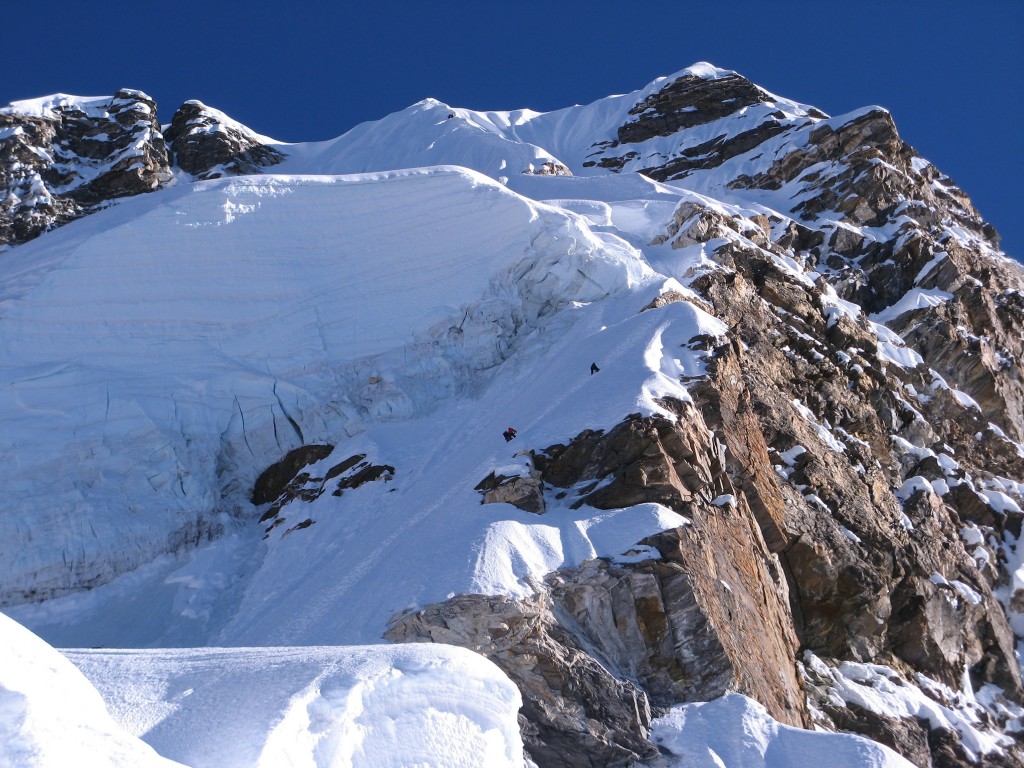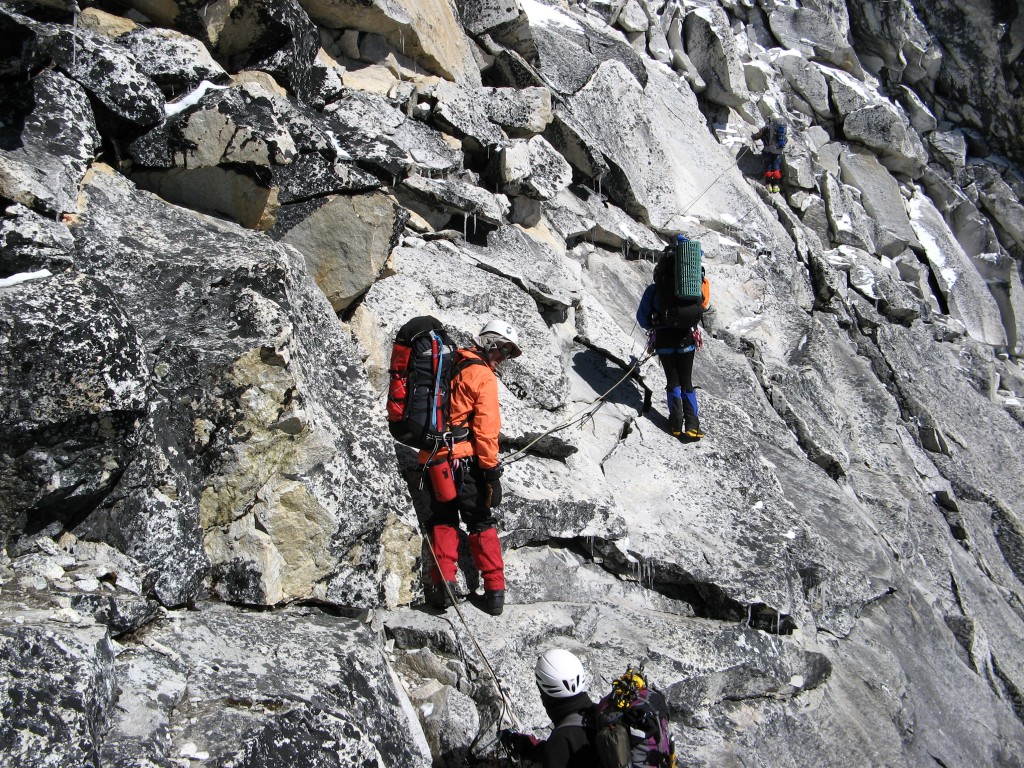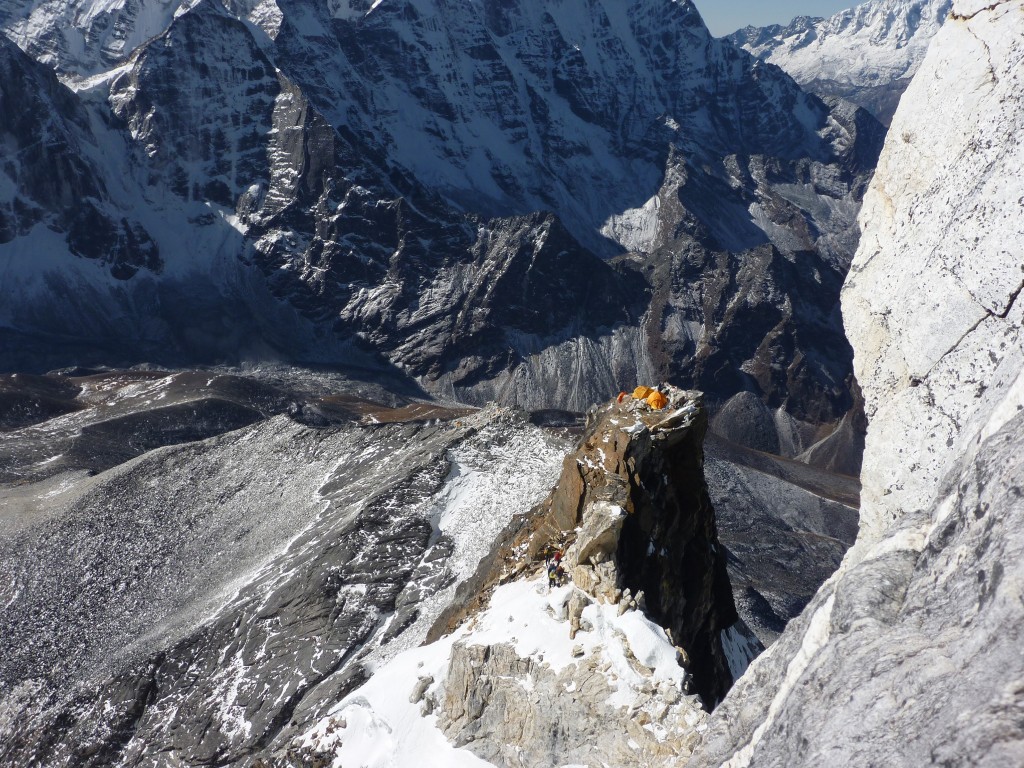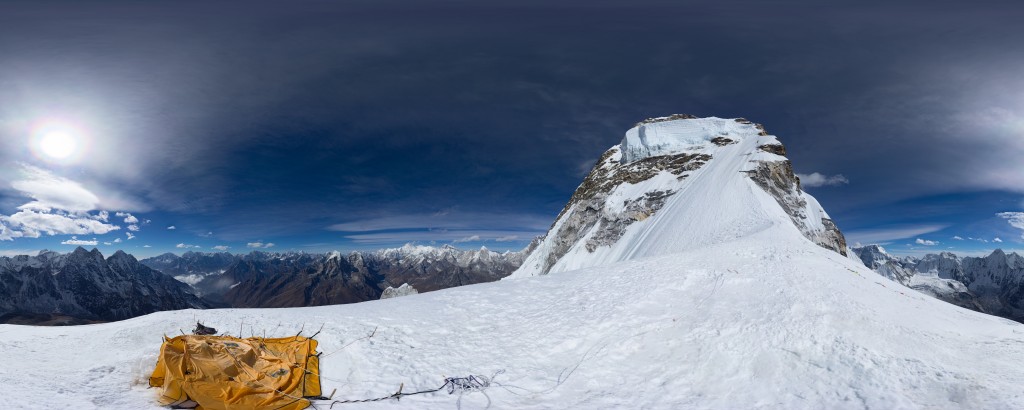Ama Dablam
viaThe SW Ridge

Suggested list of skills required for attempting Ama Dablam
I often get asked about Ama Dablam and what level of technical competence is required for a safe ascent. Suffice to say that you need to be extremely competent in certain skills areas and that they should be second nature if you are going to have a better than even chance of summiting.
Some people go there extremely ill prepared … and some of those people do manage to summit. Having said that some of those ill prepared summiteers then really struggle on the way down having used all their reserves in ascent. Meanwhile many of them don’t summit and others pay the ultimate price.
If you want to not only maximize your chances of success but also actually enjoy the whole experience then please, please come prepared.
Now, just because you see a programme on the telly about, or read an article by, someone who summited with little or no experience doesn’t mean that it is within the realm of everyone else out there who is similarly inexperienced. Perhaps they had a natural predisposition to being good at altitude. Maybe that person was just lucky. Maybe they are blissfully unaware of just how close they came to failure. Whatever the reason, you can’t assume that any old Tom, Dick or Harriet can do likewise.
It also gives you far better ownership of your expedition and summit success if you do it in good style and well within your comfort zone.
Ama Dablam is a pretty technical mountain but, with the use of fixed ropes, it is within the realm of mere mortals. But you still need to have certain skills and a level of understanding about the equipment you’ll be using as well as pros and cons regarding certain situations. It is not a case of monkey see monkey do.
At moderately high altitude (but it will feel like ultra high altitude!), hypoxia (lack of oxygen) will have an affect and can blur the edges of your reasoning. If you have no depth of understanding about the techniques you are using then you may well employ the wrong skill in the wrong situation with devastating consequences.
Ama Dablam is definitely a climbers mountain. You need to be well acquainted with long days on the hill, using appropriate techniques according to the terrain that you are on, and having routines in place to enable you to look after yourself on an hour by hour basis. You need to constantly take care of yourself and, in particular, avoid getting dehydrated. If you become a little bit dehydrated each day, then the cumulative effect is that at the end of 3 or 4 weeks you will be a complete liability to yourself and those around you which includes not only the Climbing Sherpas but also your fellow team members. High altitude mountaineering can be very debilitating and if you can’t even maintain your hydration then you will become much more susceptible to the effects of high altitude, Acute Mountain Sickness, HACE and HAPE as well as being far more prone to the likes of frostbite and hypothermia. In turn this will jeopardise your ability to summit. All for the sake of a few extra sips of water each day.
As an example at the end of our 2011 expedition on Everest my team didn’t look scabby, sun burnt, drawn and debilitated. In fact they didn’t look as if they’d just been to the summit of Everest! That’s because they all understood the importance of concurrent activity, having systems in place, the importance of maintaining their health and hygiene and reacting to the ever changing environment. Despite the fact that Ama Dablam is 2,000m lower it is still crucially important to be acquainted with your gear and able to react to an ever changing environment. Fitness undoubtedly does play a part on all expeditions but having systems in place, routines to follow, an understanding and respect for your surroundings and a flexible approach to an ever changing environment will pay dividends. As will a certain amount of tenacity – but not at the expense of being dogmatic or inflexible.
So I’d suggest the following as the basics required for a successful ascent of Ama Dablam (bold denotes absolute requirements whereas normal font denotes skills that would be very good to have as part of your extensive repertoire). I am assuming little or no previous experience for someone who has set themselves a 3 to 4 year goal to be on Ama Dablam.
Having said that a ‘monkey see monkey do’ approach is not to be recommended – a thorough understanding of the nuances of the different skills required and the different terrain that may be encountered comes from years’ and years’ of experience. Basically the more time you have spent in and on the mountains the better. Road side cragging is all very well but living in a tent would be a more relevant use of your time.
1. Start rock climbing (indoors AND outdoors) with an instructor on single pitch terrain (short rather than long climbs). Start this sooner rather than later. Once you have the correct grounding and instruction then spread your wings and start getting out with regular climbing partners.
Skills to be learnt
• i. how to fit and adjust a rock climbing harness
• ii. how to fit and adjust a rock climbing helmet
• iii. how to tie in to the end of the rope with a rethreaded figure of 8 knot and a stopper knot
• iv. have an understanding of the differences between ‘snap gate,’ ‘locking’ and ‘twist lock’ karabiners – when and where to use them and their potential drawbacks when used inappropriately. Attention to be drawn to the danger of a 3 way load.
• v. how to use a belay plate to safeguard the leader and how to hold a small slip or fall
• vi. understand the concept of belay plate orientation (depending on the type of device and your type of harness and depends on whether it is orientated up / down or left / right – there are very subtle differences and sometimes it is easy to have the belay plate incorrectly orientated and thus compromise its effectiveness)
• vii. how to tie and adjust a clove hitch
• viii. how to uncoil and prepare the rope for a climbing session
• ix. how to coil a rope at the end of the session (butterfly coil preferred)
• x. have an understanding of objective danger from a view of, say, rock fall potential as well as the hazard associated with having other climbers in the vicinity (particularly if they are above you)
Timescale – depending on how many times you get out, and how quickly you can attain certain skills, this may be from a year or two (minimum) to a lifetime on the rock depending on how quickly techniques are acquired. Many, many months or even years of experience will be very helpful and stand you in good stead. Indeed younger, harder climbers are usually way out performed on Ama Dablam by older, slower more experienced mountaineers.
2. Progress on to multi pitch outdoor climbs as a second and, in due course, as a leader (preferred but not absolutely essential). Aim to be seconding up to HVS so that you are comfortable on steep terrain and have a great understanding about rope and stance management, the limitations of sometimes being on small ledges and belays, how to adapt to changing weather conditions and the importance of eating and drinking whilst on the route.
Skills to be learnt
• i. how to uncoil and prepare the rope, tie in to the bottom end and correctly thread the belay plate ready for your leader to start climbing
• ii. how to correctly belay a leader, especially when they place gear above their head and then climb up to and beyond the gear (pay rope out, take rope in and then pay rope out again)
• iii. how to retrieve gear placed by a leader and how best to rack it on your harness
• iv. how to clip in on arriving at the stance and make yourself safe before being taken off belay by the leader
• v. understanding the transition at a stance (passing gear to the leader, back coiling the rope or leading through, stance management)
• vi. climbing calls used in a multi pitch environment
Timescale – Many months to many years. This should ideally be on a variety of different rock types from roadside cragging at Tremadog and Shepherd’s to long classics on the high mountain crags and perhaps some sea cliff experience. The more routes the better. You won’t be in a leading situation on Ama Dablam but if you have many many multi pitch routes under your belt then this will help you have a greater understanding about the environment that you are in. I run a technical session on using fixed ropes whilst we are at Base Camp and years of experience on the crags will pay dividends in understanding the various techniques you will be introduced to.

3. Abseiling – perhaps the most important skill that you need to have on arrival. The technical session I run at Base Camp should be a reminder and top up rather than an introduction to abseiling.
Skills to be learnt
• i. learn to abseil with an independent releasable safety rope managed by an instructor / competent friend
• Different ground to be considered :
• slabby rock faces
• vertical rock faces
• how to negotiate an intermediate overhang / rock lip
• multi pitch abseils
• abseiling diagonally across a rock face (NOTE – how to minimize the risk of a pendulum swing)
• Different devices to be used
• figure of 8
• belay plate
• figure of 8 with ‘prussik’ back up
• belay plate with ‘prussik’ back up
• understand the advantages and drawbacks of having the prussik on the leg loop and / or having the belay device extended
• Objective hazard to be considered
• avoidance of getting clothing / hair caught in the belay device
• correct way to thread a figure of 8 so that the rope can’t get caught on a rock and flip over the top of the 8
• ii. progress on to abseiling without a safety rope (initially consider having assistance from the bottom of the rope where an instructor / competent friend can weight the rope from below if necessary)
• Different ground
• as above
• Devices
• as above
• Considerations
• use of a ‘cows tail’ to extend the figure of 8 away from the harness and also facilitate easy clipping at the next belay point when on multi pitch terrain
Timescale – again this could be from a few sessions to many weeks or months. This is an essential skill but can be picked up quite easily. It is also a skill that is easy to get wrong particularly when tired and not concentrating.
Remember – There are no second chances if you make an error when abseiling.
4. Scrambling. Scrambling is moving on intermediate terrain where it is too steep to walk but not so steep as to need to be climbing all the time – but generally speaking handholds will be used quite frequently. To that end scrambling is a great way to move on mixed steep terrain quickly, with or without a rope depending on the route, and is a great way to gain height in the hills. Scrambling can be on quite easy but precipitous terrain where the consequences of a slip can be very serious. Without due regard scrambling can be conducted in what people perceive to be a safe manner, however when one person slips the consequences are that the other person / rest of the party can’t arrest their fall.
Skills to be learnt
• i. Route choice on steep scrambling terrain
• ii. How to rope up and take coils to shorten the rope between group members
• iii. How to manage the rope when scrambling and understanding the importance of not having any excess slack rope between people
• iv. Short roping where the leader and the second move together with a taught rope in ascent and descent
• v. Improvised belays and quick methods that are used to safeguard the party (including using direct belays (i.e. rope round a solid boulder) and use of the Italian hitch).
Timescale – minimum 4 to 6 months concurrent with the climbing skills being learnt

5. Use of crampons and ice axe on snowy terrain
Skills to be learnt
• i. How to walk in snow without crampons
• ii. How to kick steps going diagonally up a slope using the ice axe for balance / assistance
• iii. How to kick steps directly up a slope using the ice axe for assistance
• iv. How to descend snow slopes without crampons
• v. How to use the ice axe to arrest a fall
• vi. How to use the ice axe to create a suitable platform to stand in
• vii. The importance of boot / crampon compatibility
• viii. How to walk with crampons on
• a) terrain to be covered
• flat snowy ground
• flat snowy ground with rocks sticking out
• easy angled snow slopes (diagonal approach) up and down and correct use of the ice axe for balance
• steeper snow slopes (diagonal approach) up and down and correct use of the ice axe for balance (consider when it is no longer practical to take a diagonal line)
• steeper snow slopes facing in, going up and correct use of the ice axe for security
• steeper snow slopes facing in, going down and correct use of the ice axe for security
• traversing snow slopes facing the direction of travel
• traversing snow slops facing in to the slope
• easy angled ice and correct use of the ice axe for balance
• b) more advanced terrain to be covered
• easy angled ice with intermediate steps and correct use of ice axe for balance
• steeper icy slopes and correct use of the ice axe for balance and security
• leading or seconding steeper slopes where the use of 2 axes becomes more appropriate
• leading or seconding graded ice pitches where the use of 2 axes is required along with the security of a rope
• multi pitch snow and ice climbs in Scotland
Timescale – as with most of the skills the more the better. A minimum of a dozen or so routes in Scotland (or The Alps) through to leading Grade V or more! This not only represents time in crampons but also reflects time on the hill in the ever changing (Scottish) conditions. In The Alps you won’t tend to venture out in knarly conditions whereas in Scotland one can expect to be out in anything from a raging hoolie in a white out through to perfect toffee ice on a blue sky day (yes they do exist!). I cannot overemphasise the value of having experience in Scottish Winter Mountaineering.
6. Glacier travel
Skills to be learnt
• i. Acquaintance with glaciers will be a great bonus but not an absolute necessity. Often the glacial terrain that people encounter in, say, The European Alps, differs significantly from the glacial terrain of The Himalayas.
Timescale – A few visits to glaciated mountainous terrain would be very beneficial. Previous expeditions to altitude will be a great bonus but not an absolute necessity. The expedition is long enough for the vast majority people to acclimatise sufficiently, but if you have been to altitude previously you will be better prepared for the feeling of utter breathlessness.
7. Hill sense and Camp craft
Skills to be learnt
• i. A general awareness of how best to pack a rucksack. Understand the importance of prioritising what goes where according to the weather conditions and the anticipated length of your journey. A guide or leader can determine a lot about a person’s experience by the appearance of a their packed rucksack. Strange bulges and odd gaps give away an awful lot about your inexperience whereas an efficiently packed rucksack will not only carry and travel better but gives us increased confidence in your camp craft and mountain sense.
• ii. Knowledge of the ‘layering’ system and how to adjust your temperature when on the move (rather than stopping, removing clothing and starting again only to stop and put it back on again in the shade 10 minutes later)
• iii. Acquaintance with getting gear and clothing out of, or putting it back in to, your rucksack without the possibility of it blowing away (sometimes trickier than it sounds and on Ama Dablam could lead to a life threatening situation or jeopardise your summit bid)
• iv. General awareness of where and when to stop when hiking and when to take on fluids and food
• v. Personal administration throughout the day
• vi. How to pitch a tent (done for us on Ama Dablam by the Climbing Sherpas but a good skill to have just in case)
• vii. Use of stoves and how to cook when camping. Think about concurrent activity – get the stove on and then have a rest. When you have recovered, Hey presto!, you have hot water. Remember that fluids are more important than food and food is more important than sleep. If you can develop slick and efficient systems you’ll be resting whilst the stove is on heating water, then you’ll be cooking whilst having a drink and then you’ll be heating yet more water whilst having your meal
• viii. General tent routine. Over the years I have come to realise that tent routine is actually a far more important factor for people to understand than I had initially thought. What came naturally to me was, for some people, totally alien. As a result of poor tent routine and a lack of attention to detail people don’t get the water, food and sleep that they ought to which, in turn, means that they aren’t as hydrated, fit, healthy and acclimatised throughout the duration of an expedition as they could have been. Having ‘a place for everything and everything in its place’ sounds incredibly obsessive, however, knowing where things are can dramatically improve the experience of staying in a tent – especially when you are at altitude and where the pitch isn’t necessarily perfect. Throw in some night time sub zero temperatures and the associated frost storm you that will ensue inside the tent the next morning and it’s a triple whammy.
If you know where your matches are (and that they are always popped back into a plastic bag); if you know where your food is; if you know where you keep your drinks and snacks; if you don’t knock over your cup of tea (because it’s always in a bottle with the lid screwed on); if you never lose your suncream; if you always know where you keep your lip salve and that your torch is at hand throughout the night then you will be in a better condition the next day than you would otherwise have been.
Remember – water is more important than food and food is more important than sleep (and at even higher elevations oxygen is more important than water). On the mountain you won’t drink enough, you won’t eat enough and you won’t sleep enough – but you mustn’t just accept that as a fait accompli. You must continually strive to keep hydrated and you must maintain your energy levels by topping up on the intake of food, even if you have lost your appetite – and you’ll do this much better if you have a tried and tested tent routine.
It also goes some way to reiterating the fact that rest days at Base Camp are vitally important. When you are at Base Camp you are not wasting time … you are taking on fluids and energy, catching up on sleep … and acclimatising.
Timescale – as much as possible so that everything becomes second nature.

8. Altitude
• i. It would be good to have been to moderate altitude a number of times so that the feeling of breathlessness on exertion will not be alien. This can either be when going on to Alpine glaciers, when on a backpacking trek or an expedition to moderate to high altitude.
• ii. Knowledge of Acute Mountain Sickness, HACE and HAPE would be of benefit but not essential. There are comprehensive notes on my Everest website.
Another aspect about being ready for the expedition is your mental preparation. It’s all very well having the technical skills and being fit but if you aren’t psychologically ready for the trip then you may well end up not summiting for other reasons. Have a look at some of the reasons why people don’t summit Ama Dablam.
If you have any comments and / or questions then don’t hesitate to get in touch.
And if you require any tuition in any of the above skills or techniques then please don’t hesitate to get in touch and we can compare diaries. The cost per day for 1:1 instruction is £250.
You don’t always get that continuity elsewhere do you?

